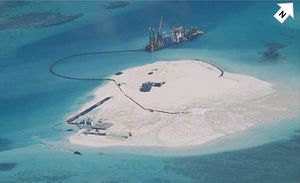China’s island-building in the South China Sea is drawing to a close, Foreign Ministry spokesperson Lu Kang announced on Tuesday. “[A]s planned, the land reclamation project of China’s construction on some stationed islands and reefs of the Nansha [Spratly] Islands will be completed in the upcoming days,” he said in a statement.
The remark comes after a renewed United States push to get all claimants in the South China Sea to stop building projects. As U.S. Secretary of Defense Ashton Carter put it in his speech at the Shangri-La Dialogue, “there should be an immediate and lasting halt to land reclamation by all claimants.”
At the time, there was little acceptance from any of the claimants, including China. “China’s construction work on some garrisoned islands and reefs of the Nansha [Spratly] Islands is totally within China’s sovereignty,” Foreign Ministry spokesperson Hua Chunying said in a statement responding to Carter’s speech. “It is lawful, reasonable and justified, not affecting or targeting any other countries.”
So why is China announcing an end to the reclamation now?
The Chinese government was quite clear that this was not an acquiescence to pressure, whether from rival claimants, ASEAN, or the United States. Lu’s statement included what has become China’s standard defense of its land reclamation, hitting all the major points: China has sovereignty over the Spratlys and thus is entitled to build on them; China’s construction does not target any other country and will not affect freedom of navigation and overflight; the upgrading of facilities is mainly aimed at civilian purposes, including maritime search and rescue and navigation safety. China’s construction activities “are thus beyond reproach,” Lu concluded. The construction is drawing to a close because it will be “completed,” not because China is abandoning the project.
Still, the announcement is undoubtedly intended to ease tensions in the disputed area, which have grown sky-high thanks to China’s island-building and an increasingly muscular response by the United States. Beijing is effectively reassuring neighbors that it will not continue reclaiming land in perpetuity. Once this particular fait accompli is in fact accomplished, China will end its construction (though of course it could start again at any time). In essence, China is hoping to get the benefits of stopping construction (in terms of reaping goodwill from its neighbors) plus the benefits of having completed construction.
There are a number of reasons for China to stop now, and Beijing may have been planning all along to have its land reclamation projects wrap up around this time. To start with the simplest reason, typhoon season in the South China Sea will start revving up soon – merely from a logistical stand-point, Beijing would want to have its construction completed early in the summer to avoid the worst storms.
There are also political factors at play that make finishing construction now an attractive option. The Philippines’ international arbitration case concerning the South China Sea dispute will start oral arguments next month. While China has consistently refused to participate, and denied that the arbitral tribunal even has the jurisdiction to hear the case, it’s still prudent for Beijing to avoid making provocative moves while the tribunal is hearing Manila’s arguments.
Plus, China-U.S. relations have been growing steadily rockier, thanks in large part to the South China Sea issue. With President Xi Jinping’s first state visit to the United States coming up in September, both sides need some positive momentum, preferably before the next Strategic and Economic Dialogue kicks off later this month in Washington, D.C. Thinking in the slightly longer term, the United States will also be moving into election season in earnest next year, and China likely doesn’t want its South China Sea actions to be a major point of debate for would-be presidential candidates. Officially, China will be adamant that U.S. pressure had no influence on its decision, but vocal concern from U.S. officials did raise the political stakes for China to continue indefinitely with its projects.
And from a big-picture point of view, China may simply have decided that an end to the land reclamation is in its best foreign policy interests. With the projects completed, China will now turn to damage control on its relationships with Southeast Asian countries – relationship that will be crucial to furthering China’s overarching foreign policy strategy, the Silk Road Economic Belt and Maritime Silk Road. As Xue Li of CASS recently argued, “In implementing the OBOR [One Belt, One Road] strategy, it’s unlikely China can avoid problems arising from the disputes; hence, it is necessary for Beijing to adjust its South China Sea strategy and policies.” Publicly announcing an end to the reclamation is China’s olive branch to ASEAN, extended in the hopes of jump-starting the “Belt and Road.”
To be clear, after the construction finishes (and there’s no exact timetable for that) China will have exactly what it wanted – newly-created islands housing new or updated facilities that strengthen China’s ability to operate in the South China Sea. Whether it sends military vessels or simply fishermen, the Chinese presence will undoubtedly increase thanks to new facilities to cater to its ships. The example of the oil rig crisis of last year is constructive – China removed the rig only after its work was completed and the point had been made, and has been working ever since to repair its relationship with Vietnam. Beijing is walking a delicate line, trying to balance an assertive approach to its claims without irreparably damaging its relationships. That means China’s approach often moves in cycles – from assertion to reassurance back to assertion – as it balances these two aims.
It looks like we’re heading back into the “reassurance” part of the cycle, which we last saw in late 2013 when Xi Jinping first announced the Maritime Silk Road. But once relationships in the region are stable enough, China may decide its facilities need more upgrading – starting the process all over again.

































